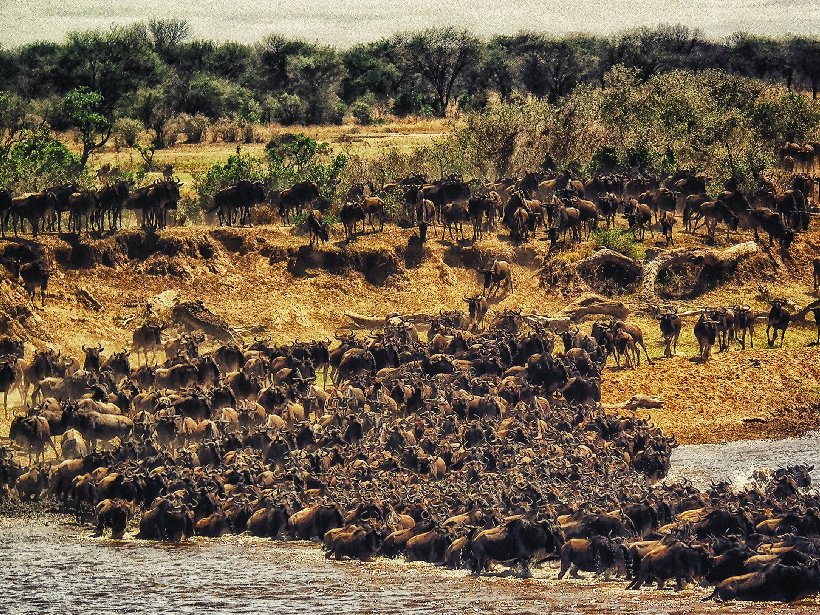A translation of this article was made possible by a partnership with Planeteando. Una traducción de este artículo fue posible gracias a una asociación con Planeteando.
The most famous migration in the animal kingdom is undoubtedly that of wildebeests. Every year, roughly 1.2 million of the ungulates wind their way through Africa’s Serengeti ecosystem. Researchers now have preliminary evidence that this record-setting migration is dictated by more than just precipitation patterns: Soil chemistry is also a likely driver.
A Perilous Journey
Wildebeests resemble shaggy cows with long, skinny legs. “They look funny,” said Simon Kübler, a geoscientist at the Ludwig Maximilian University of Munich. “They look like a mixture of several animals.” Most people know the animals from nature documentaries showing them traversing the Mara River, a perilous crossing marked by drownings and hungry crocodiles.
“The Serengeti is one of the last great migratory systems we’ve got left.”
Every year, the animals journey roughly 500 kilometers through wide plains covered with short grasses, as well as through wooded areas and landscapes with mixed grasses and shrubs. They’re following the route that their ancestors did, and that movement merits study, said Josephine Mahony, an environmental scientist at the University of Oxford not involved in the research. “The Earth has lost a lot of its migratory ecosystems over time. The Serengeti is one of the last great migratory systems we’ve got left.”
Scientists have often studied wildebeest migration from a climatic perspective but rarely from the angle of rock chemistry and weathering, said Kübler. And what’s in the ground might have a significant influence on animal grazing patterns because soil nutrient levels modulate vegetation growth.

The Chemistry of the Serengeti
Last October, Kübler and three colleagues from German and African institutions met in Serengeti National Park in Tanzania. Starting in the southeastern part of the park, the researchers spent 2 weeks in a beige Toyota Land Cruiser retracing the wildebeests’ clockwise migration route.
Along the way, Kübler and his collaborators collected samples of rock, soil, and vegetation. The aim, said Kübler, was to obtain a “chemical fingerprint” of the landscape. That fingerprint would allow the team to determine how factors such as geology, volcanism, and tectonic activity might be affecting soil chemistry and nutrient availability, which in turn influence vegetation growth and therefore migration patterns.
Most of the samples are still awaiting analysis in a laboratory in Arusha, Tanzania, said Kübler. But the team, represented by Eileen Eckmeier from the Ludwig Maximilian University of Munich, presented several preliminary results at this month’s EGU2020: Sharing Geoscience Online, a virtual series hosted by the European Geosciences Union.
The site farthest south that the team sampled—within the animals’ springtime grazing grounds—is characterized by soils enriched by a nearby volcano, the researchers found. Ol Doinyo Lengai, roughly 50 kilometers east of Serengeti National Park, holds a unique honor among volcanoes: It produces magma rich in sodium and calcium. (That’s unlike most other volcanoes, which spew out silica-rich magma.)
Ash from Ol Doinyo Lengai rains down on the southeastern part of the park and sprinkles calcium into the soil, Kübler said. “You can see calcium carbonate concretions in the soils.”
“The geological system that’s underlying the entire ecosystem might be stable for longer periods of time.”
This nutrient contributes to soil fertility, which in turn promotes vegetation growth. Calcium also helps animals develop strong bones. It’s probably not a coincidence that wildebeests graze here with their young, said Kübler. “We believe that the activity of Ol Doinyo Lengai, as the calcium source for the southeastern part of the ecosystem, is critical for keeping the migration alive.”
The next site that the team visited was a transitional grazing spot where wildebeests spend late fall and early winter. Chemical analyses are still in progress, but “we believe that the nutrient levels in the soils [here] are probably the lowest,” said Kübler. “Wildebeest can only stay for a limited amount of time until they migrate farther north.” Water-induced erosion likely contributes to the poor soil quality in this region, the team concluded.
The third and final site the scientists analyzed was near the northernmost border of the park, where wildebeests spend the late summer and early fall. Because of high precipitation levels in this area, rocks experience more chemical weathering, the team hypothesized, which releases nutrients into the soil and promotes vegetation growth. Furthermore, there’s a source of fresh rock because tectonic activity and uplift are occurring near this part of the park, said Kübler. “Tectonic processes can expose fresh and unweathered rocks.”
In the future, Kübler and his colleagues plan to study the timescales over which geologically important processes like volcanism and tectonic activity occur. “Climatic signals may be active on shorter timescales,” said Kübler. “The geological system that’s underlying the entire ecosystem might be stable for longer periods of time.”
—Katherine Kornei (@KatherineKornei), Science Writer
Citation:
Kornei, K. (2020), Geology and chemistry drive animal migration in the Serengeti, Eos, 101, https://doi.org/10.1029/2020EO144423. Published on 27 May 2020.
Text © 2020. The authors. CC BY-NC-ND 3.0
Except where otherwise noted, images are subject to copyright. Any reuse without express permission from the copyright owner is prohibited.

